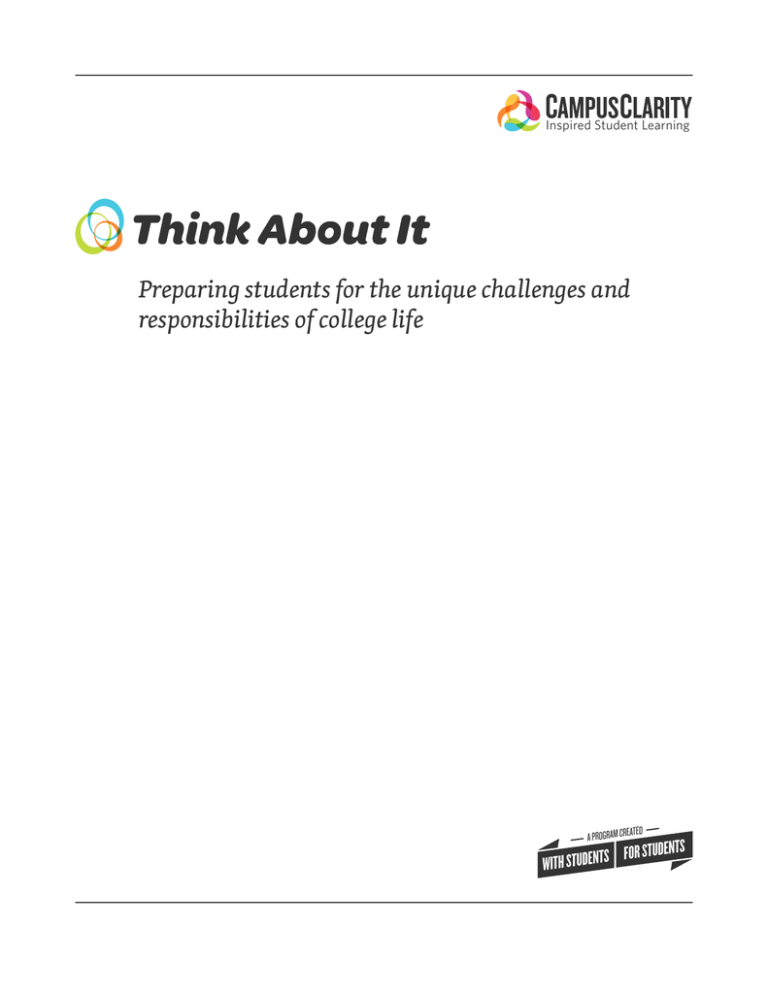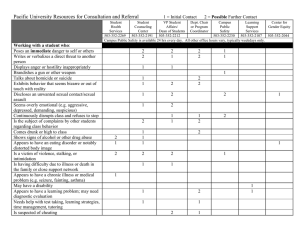
Inspired Student Learning
Preparing students for the unique challenges and
responsibilities of college life
TED
A PROGRAM CREA
THINK ABOUT IT
At a Glance
Designed to minimize risks associated with alcohol, drugs, and sexual
violence, Think About It is a research-based, comprehensive training
program that empowers students to make healthy choices.
Online Training
Courses
In-depth
Reports
Offline Support
Materials
Provide administrators with tools to respond to the
needs of their student body.
Think About It Offers
A comprehensive harm-reduction approach
Live social norming
that addresses the relation between sexual violence
and substance abuse.
to encourage a community of responsibility.
Engaging content developed with students
procedures, and resources.
through focus groups and usability testing.
A research-based program
that promotes bystander intervention.
Customizable campus policies,
Compliance with the Campus SaVE Act —
state-specific compliance.
Extensive reports and follow up courses to
inform campus harm-reduction programs.
2
A Comprehensive
Harm-reduction Approach
National statistics on rape and sexual violence in the
United States are deeply troubling:
VICTIMS OF RAPE OR ATTEMPTED RAPE:
1WOMEN6
IN
1MEN33
IN
College women are at even greater risk:
between 1 in 4 or 5 women experience rape or
attempted rape while in college.
Substance abuse is also endemic at many
colleges and universities, with tragic
consequences. The National Institute on
Alcohol Abuse and Alcoholism reports that
1,825 college students between 18 and 24 die
each year from alcohol-related injuries, a further
690,000 are assaulted by another student
who has been drinking, and 150,000 develop
alcohol-related health problems.
Other harm-reduction programs treat these
problems in isolation from one another. Yet
substance abuse and sexual violence are deeply
connected:
• Half of all sexual assaults are
committed by men who have been
drinking.
• Half of all sexual assault victims report
that they had been drinking when they
were assaulted.
• Each year over 97,000 students
between 18 and 24 suffer alcoholrelated sexual assault or rape.
3
Based on this well documented connection,
researchers and educators have called for harmreduction programs to incorporate training
on both substance abuse and sexual assault.
Indeed, one of the primary conclusions of the
Campus Sexual Assault Study completed in
2007 for the National Institute of Justice was
“the need to incorporate alcohol and drug
messages into sexual assault prevention and risk
reduction programs” (vii).
In its April 4th, 2011 Dear Colleague Letter on
Title IX and sexual misconduct, the Department
of Education reinforced this message by
recommending schools provide “information
on the link between alcohol and drug abuse
and sexual harassment or violence and best
practices to address that link” when training
Title IX coordinators and other employees
involved in redressing campus sexual violence
(17).
Unfortunately, most training programs do not
focus on this relationship. As one study noted,
“[A]lcohol use is a central factor in most
college rapes. Paradoxically, few rape preventive
interventions focus on alcohol use” (MohlerKuo et al. 43).
Think About It is different. It directly addresses
this connection, broadening the narrative of
harm-reduction programs by examining college
hook-up culture and sexual violence within the
context of partying, drugs, and alcohol.
Background
Think About It is a collaboration between CampusClarity,
a service of LawRoom, and the University of San Francisco’s
(USF) Division of Student Life.
USF is a Jesuit institution of
higher education, serving a
diverse undergraduate population
of over 6,000 students and a
graduate population of over
3,500 students.
LawRoom provides online training to employers’ supervisors
and non-supervisors, helping them understand their legal
rights and obligations. Its staff includes experienced lawyers,
educators, artists, and instructional designers. LawRoom has
trained over 3,000 companies, large and small, private, nonprofit, and government entities.
4
The collaboration combines LawRoom’s
expertise in legal compliance and online
training with USF’s experience handling the
unique social challenges students face in their
transition to college life.
the scenarios and tone failed to resonate the
with students, the message and material — no
matter how carefully presented or researched
— would be lost.
Numerous department representatives and
programs at USF, including the Gender and
Sexualities Center and Health Promotions,
helped develop learning objectives and course
content. During the development process, USF
and CampusClarity hosted a conference with
faculty and staff from 30 universities. This
extended collaboration helped prepare the
course for a diverse group of campuses.
To ensure that Think About It would resonate
with students, focus groups and user panels,
tested the course at every milestone. Students
helped refine the voice and tone of the course
and make certain scenarios reflected real-world
situations students actually find themselves
in. Usability testing confirmed that students
could successfully navigate the interactions,
understand the interface, and follow the stories
and learning points.
Though administrator and faculty input and
feedback were invaluable for defining learning
objectives and crafting course content,
ultimately Think About It speaks to students. If
The result of this collaboration is a course that not only
meets the highest standards of faculty and administrators,
but one with tone and content that reaches students where
they are.
USF and CampusClarity continue to collaborate closely
on improving Think About It and in developing a suite of
courses that include follow-up and sanction courses.
5
Research Based
Think About It’s learning objectives are firmly grounded in
the most current theory and research about harm-reduction
on college campuses and instructional design.
Think About It’s goal is to provide students
with the necessary confidence and skills to
intervene before sexual assault occurs, to
speak out against stereotypes and attitudes
that perpetuate sexual violence, and to support
survivors.
Bystander Intervention:
This approach helps create a community of
responsibility, where men and women are equal
partners in prevention.
There are five stages to bystander intervention.
Problems at any one of these stages can stop
an intervention. A bystander must notice the
problem, understand it demands action, feel
responsibility to act, choose what form of
assistance to provide, and respond.
Helping students speak out and step up
Think About It aims to empower students to
intervene in high-risk situations involving sexual
violence or substance abuse.
Think About It Addresses Each Stage Of
Bystander Intervention By:
Alerting students to the prevalence of sexual
Modeling effective intervention strategies to
violence and substance abuse on college campuses.
motivate students to intervene and show them how
to successfully intervene.
Informing students about substance abuse and
sexual violence to help them identify and avoid
high-risk situations.
Providing students with an opportunity to
practice these skills in realistic scenarios, helping
them develop the confidence to intervene.
Stressing a community of responsibility.
6
Social Norms Approach:
Fostering a community of responsibility
Even with the proper skills and knowledge,
however, students may be reluctant to step in
if they feel the broader campus culture does
not support intervention. To address this issue,
Think About It uses social norming to encourage
an environment more supportive of intervention
by shifting social norms and creating social
pressure to act.
College students often hold exaggerated views
of their peers’ alcohol and drug use, sexual
activity, and beliefs about gender stereotypes.
These exaggerated views can be harmful,
causing students to engage in more highrisk behaviors or not to intervene in high-risk
situations.
For example, most men do not support beliefs
and attitudes that excuse or condone sexual
violence. But they are often afraid to speak up
when confronted with harmful language or
behavior because they mistakenly believe that
other men will not support them. In their desire
to conform, they stay silent. Their silence can
serve to perpetuate and even reinforce these
myths.
Live social norming lets students see more
accurate reflections of their peers’ behaviors,
which should reduce the social pressure to
drink, use drugs, or engage in risky sexual
activity, while increasing the incentives to
intervene and speak up.
“Insights” Social Norming
Questions that display real-time
response data from the university’s
student body.
7
Multifaceted Approach
Instructional Interactivity
Think About It follows best practices in
e-learning and performance improvement. It
motivates and engages students with content
tailored to a college-aged audience of digital
natives. It offers:
The course features a variety of interactions
that allow students to apply what they’ve
learned, practice good decision-making when
faced with common problems in the college
setting, and explore content of particular
interest. Scenario-based case studies provide
learners with a wide range of situations in which
they can decide how to respond. Conversation
models help to address common myths
regarding alcohol, drugs, and sex. Animated
branching stories deliver life-like dilemmas that
allow students to practice their skills in realistic
environments.
•
•
•
•
•
•
a non-judgmental approach
real-world stories and scenarios
game-like interactions
rich media environment
segmented lessons
additional materials for on campus
programming
Think About It does not simply tell students what
to do but helps them find their own reasons for
change.
The BAC Apparatus
An interactive tool that encourages
students to explore the effects of
alcohol on their body.
8
Rich Media
Think About It presents complex concepts
through infographics, interactive visualizations,
motion graphics, videos, and sound design
and narration. Rather than a one size fits all
approach, the media fits the message. This rich
media environment makes difficult ideas more
relatable and involves students in the material
emotionally as well as intellectually, helping
improve understanding and retention.
Think About It is primarily an e-learning
platform. However, it is one part of more
comprehensive programming. Supporting
multi-media resources are available for faculty,
administrators, and students for use on campus.
These resources include posters and discussion
guides that expand the topics explored in the
course.
Incentives & achievements
Points and badges motivate students to engage
with the course comprehensively. The course
rewards those who answer questions correctly
on the first try and those who interact with
optional materials that dive deeper into specific
topic areas.
9
Conclusion
Our goal is to promote a safer campus environment for students
by helping them make healthier, better informed decisions about
relationships, sex, drugs, and alcohol.
A developing body of research suggests
that the years between 18 and 25 constitute a
critical developmental stage, called “emerging
adulthood.” In this stage, young men and
women experience new levels of autonomy and
experiment with possible life directions. Some
educators even claim that the emotional and
social development college students undergo
exceeds their intellectual development.
By helping students at the start of their college careers,
Think About It won’t just help make their college
experiences safer and healthier. It can have a lasting
impact on their lives.
Version 1.0
10



